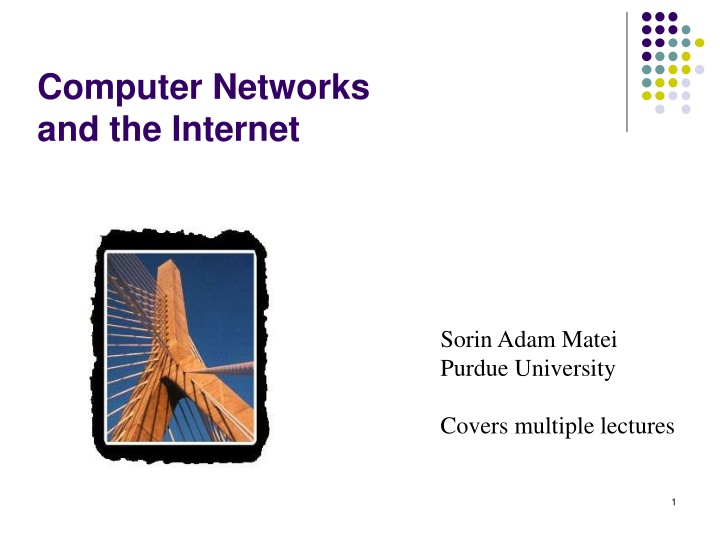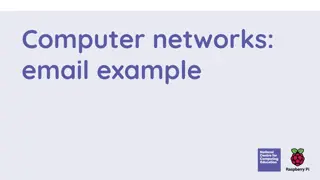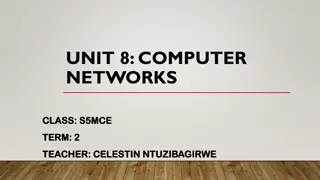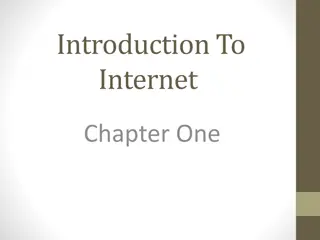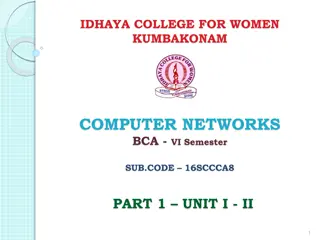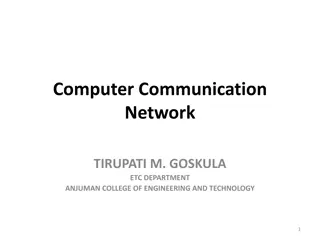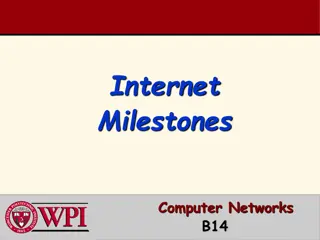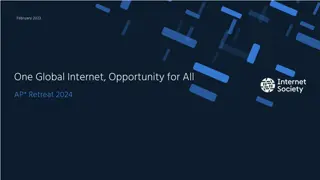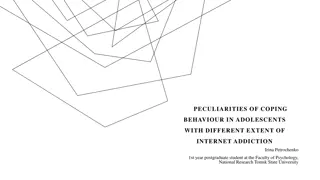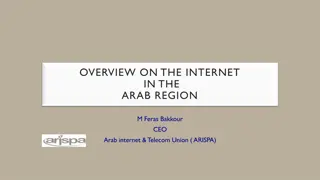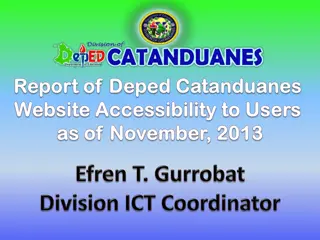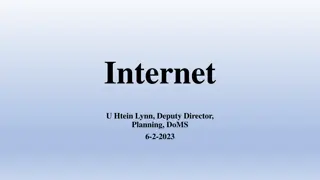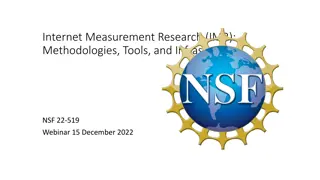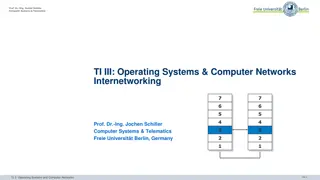Computer Networks and the Internet
Structure and protocols of computer networks and the Internet through lectures covering topics like Internet providers, protocols, history, network edge, core, and net neutrality. Delve into the nuts and bolts view of the Internet and learn how computers connect through routers and gateways.
Uploaded on Feb 19, 2025 | 0 Views
Download Presentation

Please find below an Image/Link to download the presentation.
The content on the website is provided AS IS for your information and personal use only. It may not be sold, licensed, or shared on other websites without obtaining consent from the author.If you encounter any issues during the download, it is possible that the publisher has removed the file from their server.
You are allowed to download the files provided on this website for personal or commercial use, subject to the condition that they are used lawfully. All files are the property of their respective owners.
The content on the website is provided AS IS for your information and personal use only. It may not be sold, licensed, or shared on other websites without obtaining consent from the author.
E N D
Presentation Transcript
Computer Networks and the Internet Sorin Adam Matei Purdue University Covers multiple lectures 1
Introduction Our goal: get context, overview, feel of networking approach: descriptive use Internet as example Overview: what s the Internet what s a protocol? network edge network core access net, physical media Internet/ISP structure/net neutrality history 2
Roadmap 1.1 What is the Internet? Internet Structure & Internet Providers 1.2 Internet Protocols 1.3 History 1.4 Network edge/core packet switching E2E net neutrality 3
Whats the Internet: nuts and bolts view router Internet: network of networks workstation server mobile loosely hierarchical Nestled into each other (onion metaphor) local ISP regional ISP Internet standards Open Free Protocols the only thing that is unique to the Internet are its specific standards company network 4
Routers/gateways A network of Networks Q: How do computers connect to the Internet? residential access nets institutional access networks (school, company) mobile access networks LANs WANs PANs 5
LOCAL NETWORKS TALK TO LOCAL ACCESS PROVIDERS LOCAL PROVIDERS TALK TO REGIONAL PROVIDERS REGIONAL PROVIDERS TALK TO GLOBAL PROVIDERS local ISP local ISP Tier 3 ISP local ISP local ISP Tier-2 ISP Tier-2 ISP Tier 1 ISP NAP Tier 1 ISP Tier 1 ISP Tier-2 ISP local ISP Tier-2 ISP Tier-2 ISP local ISP local ISP local ISP 6
Internet structure: network of networks roughly hierarchical at center: tier-1 ISPs (e.g., MCI/Verizon, Level3, Sprint, AT&T), national/international coverage treat each other as equals Tier-1 providers also interconnect at public network access points (NAPs) Tier-1 providers interconnect (peer) privately Tier 1 ISP NAP Tier 1 ISP Tier 1 ISP 7
Tier-1 ISP: e.g., Sprint Sprint US backbone network 8
Internet structure: network of networks Tier-2 ISPs: smaller (often regional) ISPs Connect to one or more tier-1 ISPs, possibly other tier-2 ISPs Tier-2 ISPs also peer privately with each other, interconnect at NAP Tier-2 ISP pays tier-1 ISP for connectivity to rest of Internet tier-2 ISP is customer of tier-1 provider Tier-2 ISP Tier-2 ISP Tier 1 ISP NAP Tier 1 ISP Tier 1 ISP Tier-2 ISP Tier-2 ISP Tier-2 ISP 9
Internet structure: network of networks Tier-3 ISPs and local ISPs last hop ( access ) network (closest to end systems) local ISP local ISP Tier 3 ISP local ISP local ISP Local and tier- 3 ISPs are customers of higher tier ISPs connecting them to rest of Internet Tier-2 ISP Tier-2 ISP Tier 1 ISP NAP Tier 1 ISP Tier 1 ISP Tier-2 ISP local ISP Tier-2 ISP Tier-2 ISP local ISP local ISP local ISP 10
Internet structure: network of networks a message can pass through many networks! local ISP local ISP Tier 3 ISP local ISP local ISP Tier-2 ISP Tier-2 ISP Tier 1 ISP NAP Tier 1 ISP Tier 1 ISP Tier-2 ISP local ISP Tier-2 ISP Tier-2 ISP local ISP local ISP local ISP 11
Roadmap 1.1 What is the Internet? Internet Structure & Internet Providers 1.2 Internet Protocols 1.3 History 1.4 Network edge/core packet switching E2E net neutrality 12
Protocols Connect computers that do not speak the same language Not embedded in a particular operating system Are simple sets of instructions Are the Internet s operating system Without them the Internet would not exist 13
Whats a protocol? human protocols: Specific way of asking a question Expected responses May I please have that sandwich? Yes, you may network protocols: machines rather than humans all communication activity in Internet governed by protocols protocols define format, order of msgs sent and received among network entities, and actions taken on msg transmission, receipt specific msgs sent specific actions taken when msgs received, or other events 14
Whats a protocol? a human protocol and a computer network protocol: Hi TCP connection req TCP connection response Hi Got the time? 2:00 Get http://www.cla.purdue.edu/com <file> time Q: Other human protocols? 15
Packet switching core internet principle Send and email or request a video or webpage Messages/videos/files are broken down into small pieces Each piece is sent independently of all others on the shortest path available at the time It s like a highway Break down the shipment into individual trucks , do not send the whole train down, might get bogged down http://www.pbs.org/opb/nerds2.0.1/geek_glossar y/packet_switching_flash.html Baran, Kleinrock Roberts, Cerf 16
The Internet is a higway system, while old telephones were railroads Telephones: a line, when used by two people is "busy" - the entire bandwidth is taken by the conversation Like a railroad track that is kept closed between any two stations until the train passes Internet: a line is filled with bits of information from multiple messages, racing one past another, like a road network, cars (packets, bits) can run side by side on the same road until they occupy all the available space 17
Packet Switching All content on the internet is divided into pieces / bits pieces tagged by the UDP and TCP/IP protocol Tags tell the system what file is the piece a part of, where it fits in it, where it resides and where is being sent Pieces are sent independently of one another to their final destination Best route A message sent from Purdue to Los Angeles can be broken in 10 pieces, each of them taking a different path: Fort Wayne, Calumet, South Bend, Urbana Champaign example with Tracert - type cmd tracert ucla.edu 18
Three Important Protocols UDP (Used Datagram), TCP (Transport Protocol), IP (Internet Protocol) set of rules (protocols) used to send data in the form of message units (packets) between computers over the Internet. UDP - basic unitizing of information into packets (bits) - used for some simple transfers, cannot take care of call backs IP takes care of handling the actual delivery of the data, TCP creates a connection and takes care of keeping track of the individual units of data (called packets) that a message is divided into for efficient routing through the Internet and understandably reassembled at the other end . If a packet is lost, TCP makes sure that the receiver calls back for it. 19
What do UDP, TCP, IP do when you call a webpage ? When an HTML file is sent to you from a Web server, the protocols divide the file into one or more packets, numbers the packets, and then forwards them individually to the destination IP address. Although each packet has the same destination IP address, it may get routed differently through the network. Visualization of path taken by the North Korean Press Agency site to reach to West Lafayette (via http://www.monitis.com/traceroute/index.jsp?url=kcna.kp&testId=20396 10) - Click to visualize At the other end (the client program in your computer), TCP/IP/UDP programs reassemble the individual packets and waits until they have arrived to forward them to you as a single file. 20
IP addresses All physical computers have an IP address (198.324.9.009) see syllabus resources Domain names (addresses matei.org, veffort.us, purdue.edu) are assigned to an IP address (reside on a physical computer), but there could be several domains assigned to a single computer with a unique IP address Domain names should be bought, there are no automatic domain names They are in the format purdue.edu, name.tld The computer you use to access the web has an IP address as well 21
More protocols The Internet uses a set of protocols, stacked on top of each other Ethernet (hardware) TCP/IP (addressing; essential; packet switching) FTP (file transfer) HTTP (file and link connectivity) VOIP (voice of the internet, not one, but several) RTSP (radio/voice protocol used for streaming audio) 22
Tracert, whois, visual path PC Start > type cmd Type tracert matei.org Mac Terminal traceroute matei.org 23
Roadmap 1.1 What is the Internet? Internet Structure & Internet Providers 1.2 Internet Protocols 1.3 History 1.4 Network edge/core packet switching E2E net neutrality 24
Why should we know anything about Internet history? Internet technologies (protocols, connections) born over time - We had Internet connections before the public knew about it (@20 years) No definite goal from the very beginning - goals emerged First Internet-like network 1969 - experimental, scientific collaboration Internet as we know it - 1980 Made to be be efficient and flexible, open to innovation = as long as use was limited and distributed Various protocols invented by various people for various reasons: Example - The invention of the web by a British physicist in Switzerland to share physics papers 25
Internet History 1961-1972: Early packet-switching principles 1961: Kleinrock - queueing theory shows effectiveness of packet-switching 1964: Baran - packet- switching in military nets (experimental) 1967: ARPAnet conceived by Advanced Research Projects Agency 1969: first ARPAnet node operational 1972: ARPAnet demonstrated publicly NCP (Network Control Protocol) first host-host protocol first e-mail program ARPAnet has 15 nodes - First, primitive form of network - not a full Inter- network yet... only connected computers, not networks of computers 26
Internet History 1972-1980: Internetworking, new and proprietary nets 1970: ALOHAnet satellite network in Hawaii 1973: Metcalfe s PhD thesis proposes Ethernet 1974: Cerf and Kahn - architecture for interconnecting networks late70 s: proprietary architectures: DECnet, SNA, XNA 1979: ARPAnet has 200 nodes, ready to start interconnecting with other networks Cerf and Kahn s internetworking principles: minimalism, autonomy - no internal changes required to interconnect networks best effort service model stateless routers decentralized control define today s Internet architecture 27
Internet History 1980-1990: new protocols, a proliferation of networks 1983: deployment of final, mature form of TCP/IP 1982: SMTP e-mail protocol defined 1983: DNS defined for name-to-IP-address translation 1985: FTP protocol defined 1988: TCP congestion control new national networks: BITnet, NSFnet, Minitel 100,000 hosts connected to confederation of networks 28
Internet History 1990, 2000 s: commercialization, the Web, new apps Late 1990 s 2000 s: more killer apps: instant messaging, peer2peer file sharing (e.g., Naptser) Social media a layer on top of http - not a new protocol Only major advance Restful services and cloud computing Internet 2 - a fast internet for universities backbone links running at Gbps Early 1990 s: ARPAnet decommissioned 1991: NSF lifts restrictions on commercial use of NSFnet (decommissioned, 1995) early 1990s: Web hypertext [Bush 1945, Nelson 1960 s] HTML, HTTP: Berners-Lee 1989 - 1991 1994: Mosaic, later Netscape late 1990 s: commercialization of the Web 29
Roadmap 1.1 What is the Internet? Internet Structure & Internet Providers 1.2 Internet Protocols 1.3 History 1.4 Network edge/core frompacket switching to E2E net neutrality and the dark side of e2e and of the Internet 30
E2E - a design philosophy A way to describe at the conceptual level how things work A way to describe how Internet technologies should work together A way to emphasize the role of some Internet technologies at the expense of others A way to discuss about Internet virtues (and vices) A handy explanation for why the Internet is good at certain things and not at other things A way to understand what/who is responsible for the fact that the Internet is inherently: open, unreliable, privacy averse, vulnerable to attacks 31
Packet switching versus circuit switching (old telephone style) Is packet switching a slam dunk winner? Packet switching: divide message in small bits, send by most efficient route at the moment Great for bursty data (email, IM, web pages) resource sharing (access YouTube) simpler, no call setup, very flexible, you can add new protocols Excessive congestion: packet delay and loss new protocols needed for reliable data transfer, congestion control - none available yet and frowned upon by FCC (net neutrality) Q: How to provide telephone-like behavior? bandwidth guarantees needed for audio/video apps still not completely solved and there is a big IF this type of network can finally deliver Problem? Edge to Edge architecture.... 32
A closer look at network structure: network edge (end): applications and hosts network core: routers network of networks access networks, physical media, communication links 33
The network edge: end systems (hosts): run application programs e.g. Web, email at edge of network client/server client host requests, receives service from always-on server e.g. Web browser/server; email client/server NOTE: peer-peer model exception minimal (or no) use of dedicated servers e.g. Napster, KaZaA a different architectur - all edge e 34
The edge is Where you are Your computer and the content delivery computers connected to you Where most applications run: Web browsers Servers Media Players (Real Player) FTP programs Limewire or Edonkey 35
The network core Is the network of routers and domain name servers that make the connections possible Responsible with directing and regulating Internet traffic Generally dumb, cannot filter or prioritize traffic Because of E2E (edge to edg or END TO END or E@E e) principle Intelligence in a network should be at the edge Some of the trunk (core) wires and connections 36
Edge to Edge (END TO END or E2E) Principle The Internet is designed to be smart at the edge (your local computer, servers, applications) Dumb at the core (routers, protocols) Facilitates flexibility and interconnectivity NOTE: Lessig prefers End to End, I prefer Edge, as being more descriptive
The Network Core and Packet Switching Network core has only one mission: facilitate transport the fundamental question: how is data transferred through this net? packet-switching: data sent thru net in discrete chunks As opposed to circuit switching (classical telephony) 38
Packet Switching - a technology Like the highway system Each packet (car) gets on the highway at an entry point independently and arrives at destination the way it wants to Takes advantage of all routes available at a specific point Maximum use of available resources Difficult to schedule massive and simultaneous communication NOTE: Circuit switching (telephone) like the railroad system-a line occupied for one conversation (Train) at the time Because packets are treated equally and protocols used to manipulate them are simple -> foster simplicity and helps adding new components to the network 39
Net neutrality - a policy The basic protocol TCP/IP is designed to treat all packets the same Dispatch them all at the same speed and same priority TCP is neutral as to its content The Internet is in fact constructed with a weak core, dumb core It is an E2E network edge to edge All information is to be treated as simply and sent as fast as possible to destination Net neutrality=all content should be treated the same, no prioritizing, no censorship 40
Net neutrality exception Does not apply to wireless Internet traffic Why? Wireless companies paid for the spectrum and invested significant amounts of money in infrastructure they need to recoup their costs and should not be forced to open their networks to their competitors (contested Facetime vs ATT) Does not apply to China or IRAN China & Iran are fact is actively messing up with the protocols Create smart routers to censor searches 41
End to End (edge to edge) or E2E a design philosophy Facilitates connectivity of various computer systems and networks Fosters innovation (Lessig - innovation commons and Zittrain - generative web ) Innovation commons=you can add any application, web browser, service that is in compliance with the simple rules of TCP/IP, HTTP, FTP, VOIP, etc The Internet should be treated as a kind of commons - this fosters innovation The protocols belong to no one, can be hacked Created democratically, via RFCs Requests for proposals Protocols are not proprietary, are open and non-profit 42
Net neutrality is not only about prioritizing traffic, is also about coding HTML code Open this page and Right click > View Source Each graphic element described by tags (instructions) Used to create-recreate pages Browsers build pages from tags the way orchestras play scores The method for encoding the music (Score) is part of the http protocol Some tried to improve it creating code that only works in some browsers (Microsoft) 43
Browser overtime market share 44 In trying to create new tags and to customize IE, Microsoft killed it
You can do better than mess up with IE and html tags . You can extend the smarts at the edges Leave html alone, create programs that use things as they are Create programs to create new types of presentations and mount them on servers 3D visualizations Interactive notifications (status updates) Mashups (Google maps and Youtube) Applications (Google docs) Use the generative capabilities of the web 45
What is the generative web? A web that allows content creators to: Make edges smart Create applications in the cloud (google docs, foursquare) GW allows sending and receiving code and data along the same paths Example: a webpage is made of HTML CSS Scripts (javascript)- enhance utility-the code part of the page 46
Generative web builds on and extends the PC model The web follows the model of the PC: Universal computing Programmable Extendable PCs allow third parties to write new applications This is how PCs get infected with viruses BTW 47
Generative web and e2e It is the e2e principle that makes the web generative in two ways You can create new protocols (voip, etc) - Lessig You can create edge-smart apps Twitter, Facebook, Google Docs etc Most important Makes the web extensible by allowing you to write new services 48
What is the opposite of the generative web/network? A proprietary network Example: Compuserve old network All smarts in the core Edge dumb You cannot send code alongside data Thin/dumb clients You need to login and all content is controlled 49
The end of the generative web? Some of the greatest successes of the generative web can be its downfall: The generative web allows not only good innovations, but also bad ones Viruses and worms take advantage of the generative nature of the web, especially its proclivity to allow code to use the same paths as data Facebook, a good innovation can turned against it creator, becoming a walled garden (that s why Zittrain thinks that the future of the Internet is bleak) 50
